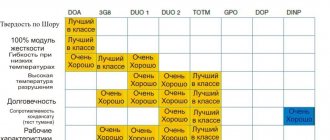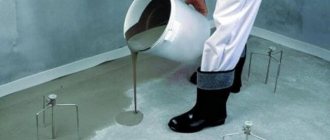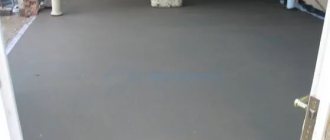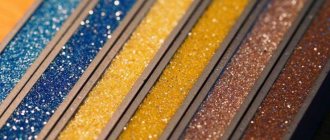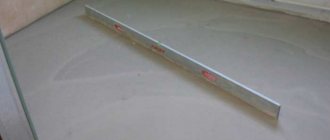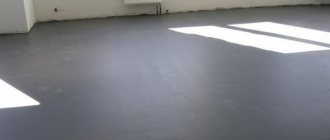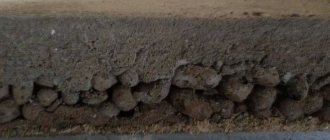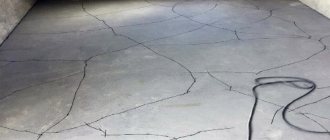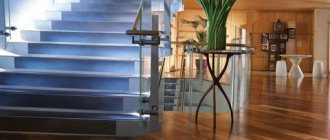During the construction process, it becomes necessary to carry out activities to fill the screed. The use of concrete and cement mortars prepared according to standard recipes has weaknesses. The cement-sand composition for leveling the base is prone to shrinkage, which causes cracking and a decrease in the strength of the floor. To increase the load capacity, mesh reinforcement is performed, the use of which increases the weight of the base. An alternative option is fiberglass screed, which strengthens the concrete surface and prolongs its service life.
Fiber fiber for screed
Why is floor screed with fiberglass performed?
The need to strengthen the concrete composition with fiber fibers is related to its properties. The hardened concrete mass has an increased safety margin. It is able to withstand compressive loads and, at the same time, loses its integrity under the influence of tensile forces and bending moments. During operation, a cement screed that does not have reinforcement gradually collapses.
Cement floor screed
A floor screed with fiber fiber evenly distributed inside the mass allows you to:
- increase the strength characteristics of the base;
- reduce shrinkage of building materials;
- increase service life;
- increase the plasticity of the floor base;
- reduce the time it takes for the mixture to harden;
- ensure resistance to temperature fluctuations;
- prevent cracking and delamination;
- evenly distribute the load on the concrete base.
The use of fiber filler improves the performance properties of the screed. Fiber fiber for floor screed has serious advantages and is used when performing repair work.
Fiber fiber for floor screed
Basalt fiber
Basalt fiber (from roving) is intended for volumetric reinforcement of concrete, mortars and composite materials.
More details
It is necessary to choose a design solution for the floor taking into account the purpose of the room and the intensity of the mechanical impact. In this case, the following must be ensured:
- durability of the structure;
- minimal labor costs for construction and maintenance;
- saving building materials;
- explosion and fire safety;
- high degree of mechanization of work;
- maximum use of the strength characteristics of soils and the properties of the materials used;
- environmental safety (no toxic fumes);
- optimal hygienic conditions;
- safe movement of people.
The durability of the coating is influenced by a number of factors:
- operating conditions – mechanical loads, degree of contact with liquids and aggressive media;
- quality of concrete components - freshness of cement, purity of inert materials and water;
- compliance with the recipe for preparing the solution - proportions, thorough mixing;
- compliance with installation technology - compliance with the selected type of coating;
- caring for fresh screed.
Fiber fiber for screed - types, characteristics, properties
Depending on the components used for manufacturing, fiber screeds are classified as follows:
- metal. The steel filler is characterized by increased resistance to temperature changes and an increased safety margin. This allows it to be used in industrial premises, where the strength and durability of concrete are negatively affected by increased loads, vibration and surface abrasion. Steel fibers are susceptible to high humidity and also have increased weight compared to fiber counterparts made from other materials;
- basalt. The reinforcing material has a set of advantages - increased resistance to open fire and temperature, resistance to corrosion processes, high humidity, and high impact strength. A filler made of basalt threads ensures the integrity of the concrete base even when through cracks occur. These advantages make it possible to use the material for pouring floors in buildings erected in seismically active zones, as well as in rooms with increased moisture concentration;
- polypropylene. Synthetic fibers made of polypropylene have reduced weight and are characterized by resistance to aggressive substances. The reinforcing material is dielectric, which allows it to be safely used both for screeding a heated floor base and as a standard leveling coating. The reasonable price of fiber filler allows it to be used in private construction to solve a wide range of problems - from floor screed to plastering walls.
Polypropylene fiber
In addition to the above varieties, the following materials are used for the manufacture of fiber reinforcement:
- fiberglass. It is used for facade cladding of buildings and the manufacture of concrete products of complex configuration;
- asbestos thread. The operational properties of the building material allow it to be used only for finishing the facade walls of buildings.
Among the fillers used to strengthen screeds, polypropylene threads are widely used, which fully replace steel filler and basalt fibers. Let's look at the characteristics:
- length is 6000–18000 µm;
- cross-sectional size is 10–20 µm;
- ability to withstand tensile loads of 1700–2600 kg/cm2;
- specific gravity does not exceed 900 g/cm2;
- the temperature threshold for ignition exceeds 300 degrees Celsius;
- the elongation coefficient at break is 1.5–2.5.
The properties of the material added to cement or concrete mortar make it possible to increase their resistance to aggressive liquids.
Basalt fiber for screed
Brown façade adhesive-sealant
CEMMIX Facade adhesive-sealant is a special sealant based on hybrid polymers for various joints.
More details
How to make screed with fiber fiber - technology of work
The sequence of actions for planning the floor surface using concrete mortar with the addition of fiber fiber corresponds to the algorithm for constructing a traditional screed. The set of measures includes the following stages:
- Finishing the surface to the required conditions.
- Determining the level of the poured solution.
- Preparation of a mixture with fiber fiber.
- Pouring the mixture and leveling it.
Let us dwell in detail on the specifics of performing individual stages of work.
Preparing the surface
Visual inspection of the base for defects.
Preparation of the base surface involves performing the following work:
- Removing existing floor covering.
- Cleaning the surface from construction debris.
- Visual inspection of the base for defects.
- Cutting detected cracks.
- Cleaning the edges of the prepared cavities.
- Abundantly moisten the surface with water.
- Sealing with cement-sand mortar.
- Clean up dust using a vacuum cleaner.
- Gluing damping tape along the contour of the walls.
The strength and durability of the coating depends on the quality of surface preparation.
Carrying out markings
Floor screed with fiber fiber is poured to a thickness determined by the height differences of the base and the purpose of the room. Before pouring the mixture for the screed, it is necessary to make markings, following the given sequence of actions:
- Identify areas of the floor with maximum differences.
- Mark the required pour height on the wall surface.
- Draw a horizontal line corresponding to the thickness of the screed.
- Install beacons on the floor in accordance with the markings.
- Secure the guides to the base with cement mortar.
Installation of beacons for floor screed and surface leveling
When performing work, pay attention to the following nuances:
- using a laser level will simplify marking the layer thickness;
- the interval between the guides should not exceed the size of the rule;
- The fixing solution for beacons must harden before the next step begins.
Having completed the activities at this stage, check the correct installation of the guides.
Preparing the mixture
You can prepare a solution containing fiber fiber for floor screed using various methods. To mix the ingredients, use one of the following methods:
- Mix Portland cement, fiber filler and fine sand thoroughly. Dilute the mixture with water, gradually adding it during the mixing process until a uniform consistency of the composition is obtained;
- add fiber strands to the previously prepared cement laitance and mix thoroughly. Gradually introduce the resulting composition into the prepared cement-sand mixture and mix until smooth;
- Prepare a standard concrete solution in a concrete mixer, following the required recipe. Add fiber reinforcement to the concrete mixer and mix the solution.
Preparing the mixture for pouring the floor screed
Let's consider the sequence of steps for preparing fiber-reinforced cement mortar:
- Mix pre-sifted sand and Portland cement in a 3:1 ratio.
- Introduce fiber fiber, the amount of which is 50% of the total volume of the solution.
- Gradually add water at the rate of 0.3–0.4 liters for each kilogram of Portland cement.
- Mix the ingredients evenly until creamy.
To ensure the strength characteristics of the screed, it is necessary to prepare a concrete solution marked M200. To prepare it you will need 250 kg of Portland cement per cubic meter of concrete.
Fiber fiber consumption per 1 m2 of screed
It is necessary to know, when introducing fiberglass for screed, the consumption per m2. It should be remembered that with increasing concentration of polypropylene fiber, the characteristics of the screed improve. Depending on the condition of the floor, the thickness of the formed layer differs. That is why it is convenient to calculate the amount of fiber reinforcement per cubic meter of solution.
Fiber fiber consumption per 1 m2 of screed
Professional builders are guided by the following proportions:
- to increase the mobility of the cement composition and better fill unevenness, you can add 0.3 kg per cubic meter of the mixture;
- to prevent cracks and increase the strength characteristics of concrete, 0.5-0.6 kg is introduced per cubic meter of cement mortar;
- The maximum effect can be obtained and the strength of the cement base can be significantly increased by introducing 0.8–1.5 kg of fibers per 1 m3 of composition.
The manufacturer of fiber fiber for floor screed indicates the recommended proportions on the packaging. Exceeding the recommended formulation may cause cracking of the screed surface.
Making a screed
Floor screed with fiber fiber is performed according to the following algorithm:
- Pour cement mortar between the beacons.
- Distribute the mixture evenly as a rule.
- Compact the material using a needle roller.
- Remove the guides after the base has cured.
- Fill the cavities from the beacons with cement mortar.
Floor screed with fiberglass
When performing work, pay attention to the following points:
- you should start pouring from the far corner of the room;
- work must be performed in one step;
- The screed should be protected from drafts;
- It is necessary to moisten the surface from time to time.
After the material has hardened, you can begin further work on laying the finishing coating.
Features of screed for heated floors
Making screeds for heated floors has its own nuances:
To prevent heat loss, it is necessary to perform the following work before pouring the cement base:
- lay thermal insulation material;
- reliably waterproof the base.
In addition to reinforcing ingredients, plasticizing substances should be introduced to increase the plasticity of the solution and its resistance to the influence of elevated temperatures.
Fiber fiber screed for heated floors
Features: pros and cons
Fiber fiber is an artificial filler for cement mortars. It is produced in the form of small flakes that are easy to mix with other components of the mixture.
Fiber-based solutions have several significant advantages over classic products:
- Fiber fiber screed has increased bending strength. A foundation made of such materials perfectly withstands shrinkage of buildings, heaving of soils and many other loads.
- Cement mortars almost never delaminate after hardening. This is achieved due to fibers that are randomly located in the structure of the substance.
- Fiber fiber prevents the screed from cracking. But this effect is achieved only if the exact proportions recommended by the manufacturer are observed.
- Fiber cement mortar can be prepared using a small amount of water. This, in turn, accelerates the hardening of the mixture and does not allow microvoids and other negative components to form inside the structure.
- Fiber fibers are obtained from materials that do not rot or collapse under the influence of external factors.
- Once hardened, cement is not easy to wipe off, which affects the service life of both bases and decorative materials.
- The addition of fiber fibers to concrete affects the quality of waterproofing of the material. A frozen base does not allow moisture to pass through or absorb moisture.
- Fiber-based surfaces can withstand low sub-zero temperatures, at which it is not recommended to use pure concrete.
As for the disadvantages, fiber fiber and products based on it have practically none.
We produce semi-dry screed with fiber fiber
A semi-dry screed with fiber reinforcement allows you to form a reliable and even concrete base for finishing in a limited time. The technology provides:
- minimal hydration of the composition;
- reinforced with plastic fiber.
You can use a stand mixer to mix the dry ingredients evenly. Sequencing:
- Prepare the base.
- Complete the markup.
- Lay thermal insulation.
- Install and secure beacons.
- Prepare a sand-cement mixture in a 3:1 ratio.
- Add 0.6 kg/m3 fiber and mix.
- Add a little water until semi-dry.
- Lay the solution in a layer of 3–5 cm and level it.
After drying, sand the surface and cut expansion joints. Lay the finishing coating a week after pouring.
Reviews
Concrete with added fiber is perfect for domestic construction needs. According to customer reviews, this material allows, in some way, to eliminate the use of reinforcement in screeds. But at the same time, many note that the quality of the product depends on the type of fiber used and the manufacturer.
Some use fiberglass to form screeds, while large companies build industrial floors that resist cracking.
Fiber fibers are an excellent opportunity to extend the life of floors by minimizing the thickness of the concrete layer.
To learn how to screed a floor with the addition of fiberglass, see the following video.
Impact resistance
Fiber fiber provides the solution with the greatest resistance to impact and other mechanical damage. According to tests, fiber reinforced concrete is five times more impact resistant than conventional concrete.
Fiber fiber provides concrete with plasticity, which makes it less brittle and brittle. Such concrete is more resistant to impact due to the greater amount of energy that is absorbed during the tension of the fibers formed after cracks appear in the mortar.
Impact resistance allows fiber fiber to be used in heavy industry, in the construction of buildings in areas of high seismic activity, etc.
